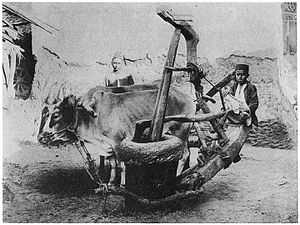Teli

Teli is a caste traditionally occupied in the pressing of oil in India, Nepal and Pakistan. Members may be either Hindu or Muslim; Muslim Teli are called Roshandaar or Teli Malik.[1]
The Jewish community of Maharashtra (called Bene Israel) was also known to be a sub-group in the Teli caste called Shanivar Teli meaning Saturday oil pressers for their Jewish custom of abstention from work on Shabbat.
Varna status
The Teli are sometimes considered to belong to the Vaishya (merchant) varna in Hinduism.[2] Other sources, however, classify them with the ritually lower-ranked Shudra (cultivators),[3][4][5] while others note that the Teli have attempted to avoid lower-classed activities and associations in an attempt to identify themselves as Vaishya.[6]
In Bengal, the Teli would be reckoned as Vaishya, along with other traders and bankers such as the Suvarnabanik, Gandhabanik, Saha, had not the Vaishya varna disappeared there.[7]
In Rajasthan, the Teli claim Kshatriya (warrior) status, though their neighbors recognise them as Vaishya.[8]
Other Teli
The Bene Israel of Maharashtra were nicknamed the Shanivar Teli ("Saturday oil-pressers") by the local population as they abstained from work on Saturdays which is Judaism's Shabbat.[9][10]
The Ghanchi community of Gujarat have been described as a "counterpart" of the Telis.[11]
Politics
In the late 2000s, some among the Teli community of Bihar, organised by the Teli Sena, were engaging in vote bank politics as they sought to achieve categorisation as an Extremely Backward Class in the state. As of 2010 they had failed to achieve this repositioning in India's official positive discrimination scheme,[12] with opposition coming from other groups who considered the Teli to be too populous and socio-economically influential to justify the change.[2]
See also
References
- ↑ People of India Uttar Pradesh Volume XLII edited by A Hasan & J C Das
- ↑ 2.0 2.1 "Bid to make Teli an EBC opposed". The Times of India. 26 May 2009. Retrieved 28 November 2013.
- ↑ Jaer, Øyvind (1995). Karchana: lifeworld-ethnography of an Indian village. Scandinavian University Press. ISBN 9788200215073.
- ↑ Khanna, L. M. (2002). Incredible story of social justice in India. Aravali Books International.
- ↑ Bendix, Reinhard; Lipset, Seymour Martin. Class, Status, and Power: Social Stratification in Comparative Perspective. Taylor & Francis. p. 29.
- ↑ Yang, Anand A. Bazaar India: markets, society, and the colonial state in Gangetic Bihar. p. 142.
- ↑ Gupta, Sankar Sen (1976). Folklore of Bengal: A Projected Study. Indian Publications.
- ↑ People of India: Rajasthan - Google Books
- ↑ Govinda Nārāyaṇa Māḍagāṽakara; Murali Ranganathan; Gyan Prakash (2008). Govind Narayan's Mumbai: an urban biography from 1863. Anthem Press. pp. 283–. ISBN 978-1-84331-277-2. Retrieved 12 February 2012.
- ↑ Orpa Slapak; Muzeʼon Yiśraʼel (Jerusalem) (1995). The Jews of India: a story of three communities. UPNE. pp. 108–. ISBN 978-965-278-179-6. Retrieved 12 February 2012.
- ↑ "Nitish Kumar's 'wait and watch' on Bihar BJP's latest Narendra Modi gimmick". NDTV. 27 May 2009. Retrieved 4 December 2013.
- ↑ Sengupta, Joy (27 September 2010). "Caste brigades drive hard bargain for their share in Assembly, keep parties guessing". The Telegraph. Retrieved 4 December 2013.